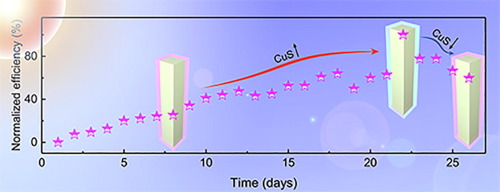Electrochemistry Communications ( IF 5.4 ) Pub Date : 2019-12-26 , DOI: 10.1016/j.elecom.2019.106648 Xiaoli Zhao , Kaiqi Zhao , Jun Su , Lidong Sun

|
Highly ordered three-dimensional (3D) heterojunctions are attractive for optoelectronic, photovoltaic and electronic devices due to their large interfacial contact and oriented charge transport. However, 3D heterojunctions of this type have rarely been reported because of the great difficulty in constructing an ordered structure at the nanoscale. In this study, a core-shell nanorod array of TiO2/CuS heterostructure is achieved by coating the TiO2 nanorods with conformal ZnS films and subsequently converting the ZnS into its CuS counterpart via ion exchange. The TiO2/CuS-based photovoltaic devices exhibit a gradually enhanced efficiency when aging in air up to 22 days. This is attributed to the progressive conversion from Cu deficient sulfide to CuS. This strategy could also be used to design other core-shell nanorod arrays based on metal oxide/sulfide heterojunctions.
中文翻译:

具有老化诱导光电转换增强作用的TiO 2 / CuS核壳纳米棒阵列
高阶三维(3D)异质结由于其大的界面接触和定向的电荷传输而吸引了光电子,光伏和电子设备。但是,由于很难在纳米尺度上构建有序结构,因此很少报道这种类型的3D异质结。在这项研究中,通过用保形的ZnS膜涂覆TiO 2纳米棒,然后通过离子交换将ZnS转化为其CuS对应物,从而获得TiO 2 / CuS异质结构的核-壳纳米棒阵列。TiO 2基于/ CuS的光伏设备在空气中老化长达22天时,其效率会逐渐提高。这归因于从贫铜硫化物到CuS的逐步转化。该策略还可以用于设计基于金属氧化物/硫化物异质结的其他核-壳纳米棒阵列。


























 京公网安备 11010802027423号
京公网安备 11010802027423号